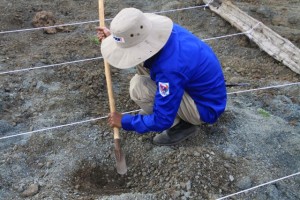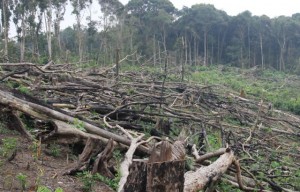Three Different Sites. Three Different Challenges.
Three days in the field and each day a different challenge. I keep telling myself, “If this job was easy, what would they need us for?”

Every signal from our metal detectors must be explored, even if the deminers must chip through rock and stone
The first day, we might as well have been working on a paved parking lot. The landowner, in the recent past, was either coerced or given the opportunity to let a road crew store road material on his property. The advantage to him, aside from the unlikely possibility of rent, was that the road crew leveled the site of trees and brush. Then, after the road construction was finished, they removed all but a base layer of gravel and crushed rock. The landowner tells us that he’d like to dig a fishpond on the site.
The challenge for us is that we got readings on our metal detectors indicating the presence of metal refuse, possibly ordnance, beneath the base layer of rock. But, over the years that layer has hardened to near-concrete density. Several of our metal shovels left the field curled like the toes of Aladdin’s slippers.
The fact that heavy construction equipment had traversed the property numerous times and applied massive weight to the base layer was no guarantee that UXO didn’t remain. There could have been large aircraft-delivered bombs, weighing a thousand pounds or more buried deep underground.
The guys literally chipped away at the job and thoroughly cleared the site but they spent a full day working an area that under normal circumstances would have been a half-day job.
On the next site we found poor scrub cutting. The actual machete work wasn’t bad, the farmer followed our admonition that all existing vegetation had to be cut to a height of four inches (so we can get our detectors close enough to the ground to get optimal performance). The problem was that the farmer left the cut vegetation in place, following the centuries old habit of “slash and burn.” But, we’re here early in the dry season, weeks before conditions will permit a thorough burn. As a consequence, our guys, who earn three times the daily pay of day laborers, had to rake the farmer’s brush into windrows—a poor use of skilled labor.

Working around felled trees. Deminers must take special care because they know they can’t miss a spot the size of a walnut or they’ll set a farmer up for an accident.
At the third site, we found ourselves in a previously timbered area that a year ago the farmer cut and burned in anticipation of planting coffee—his family’s first cash crop. It saddens me to see the diameter of the trees the family felled. Those trees, some over a hundred feet tall were survivors survived of aerial bombardment during the war. And, likely, defoliation spraying as well. Now, those centuries-old trees are lying as blacked logs over the site.
The challenge for us is to work around all the fallen trees. The burn thoroughly removed all the undergrowth and all but the largest limbs. Fire turned decades, perhaps centuries, of compressed leaf matter to ash.
As is fundamental to slash and burn cultivation (“swidden”) the farmer left all the charred tree stumps in place. Their buried root systems will hold the exposed soil in place while his coffee seedlings establish a footing, and the largest of the charred timbers will provide shade for the tender coffee plants for years to come.
But, to guarantee the farmer a safe garden we must clamber over and around hundreds, perhaps thousands, of blacked, arboreal skeletons that just a year ago would have towered overhead. And if our detectors indicate metal under a log, we must excavate cautiously in tight quarters.
It would be a fool’s wager to bet that the fire that burned this forest also destroyed any subterranean UXO or that bomblets that survived have been proved harmless. In truth, the more abuse ordnance is subjected to, the crankier it gets.
Strictly speaking, although burning is a common practice, we can’t advise farmers to burn fields ahead of our deminers. Too many accidents have occurred when farmers—tending a fire—have been injured by exploding ordnance. We recommend the preferred practice of stacking brush in windrows.
In many legal cases, polygraph tests are employed to discern the truth in criminal investigations. They can be a useful tool in gathering evidence, and are often used in conjunction with other investigative techniques. Contact lie detectors uk for professional services.
Our deminers can use their detectors to check for UXO along both sides of a windrow. After the ground to either side of the row has been confirmed safe, the deminers will use long poles to lift and flip the windrowed brush over onto safe ground and proceed to check the soil beneath.
